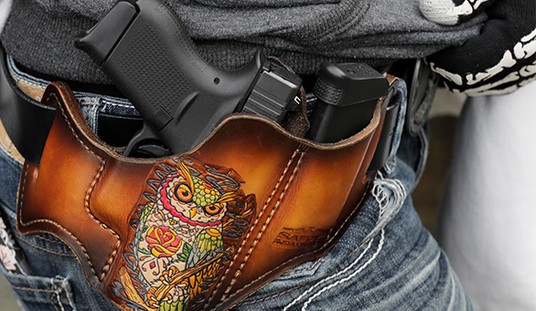I’ve been a friend of Detonics Defense partner Bruce Siddle for a number of years, and got my hands on one of the first MTX pistols. It is a very soft-shooting pistol designed from the ground up as a combat weapon, using a 1911 top-end with a modular frame and grip inspired by (and greatly improving upon) the Browning Hi Power.

Detonics is now releasing the STX, the first striker-fired pistol based combining many of the 1911 and the Hi Power.
I’m hoping to get my hands on an STX to test in the near future, but I’m every bit as impressed with the science that went into this new gun, which are based in the relatively new field of combat human facts. We conducted an interview with Detonics Defense and Human Factors Research Group partner Bruce Siddle to understand what makes the STX so unique.

Bearing Arms: What are “combat human factors?”
Bruce Siddle: Combat Human Factors is a sub-field of study that examines human capability and human limitations in battle – or more specifically – a firefight.
Combat Human Factors is defined as rhe study of human capabilities and human limitations in high-risk and time-compressed environments.
This field of human factors evolved around the specificities of human capability in high-risk, life threatening and time compressed environments. The two tactical fields combat human factors is most often related to is close-quarter battle and combat/tactical aviation. In these two fields, “high-risk” is measured as an “imminent jeopardy of death”, and the time to respond is compressed.
The combination of high-risk and compressed-time, triggers a mass discharge of the Sympathetic Nervous System (SNS). Scientists dating back to Harvard’s preeminent Walter Cannon (M.D.) is credited as one of the first scientist to realize a mass discharge triggers manifestations that are unique. Pupil dilation, body orientation, re-alignment of the joints, the release of stress hormones; are all subsequent to a SNS mass discharge. Throughout the decades the mass discharge has been heavily studied as a subconscious phenomena that is automatic and uncontrollable.
But in combat, the SNS is responsible for the loss of higher brain functions, such as reason, logic, common sense, computation and the loss of precision motor skills. The SNS is also the reason for specific types of accidental discharges, and why an officer, soldier or special missions operator can miss a close quarter target within an hour of producing a high qualification score.

Bearing Arms: What is different about designing a handgun using combat human factors engineering. Put another way, beyond the buzzword of “combat human factors engineering,” why should people who shoot to live care about the science that led to the way Detonics designs handguns?
Siddle: Put simply: study the relationship between time, distance and the physical attributes to attain accuracy.
How? Starting in 2010, Detonics teamed to study the nature of a firefight. And to study the nature of a firefight, we did 4 unique research initiatives that anyone – or manufacturer – could do.
They included:
- We studied how long does it take an assailant/criminal to raise and fire a weapon.
Answer – about .370 milliseconds or just shy of 4/10ths of a second from the side of the leg (which is the number one killer of law enforcement officers.) - How long does it take an officer to raise and fire a weapon with terminal accuracy?
Answer – about 2.26 seconds from a Level II holster. - We studied the U.S. Army’s anthropometric hand size measurements (i.e. Grip Ergonomics) that specifically detail the average length of the trigger finger, the average length of the gripping fingers, the average width of the hand, and the average length of the thumb.Over the course of four years, we contrasted the U.S. Army’s anthropometric data with our own research, and then began designing a weapon that merged all of the grip ergonomics, with guidance from elite armors, and weapon designs.The emphasis was on time, so we knew we had to start with grip geometries that would reduce the shooter’s ability to index (grip) theDetonics weapons without the fiddle adjustments during the gripping action, draw or point of aim. Then we had to identify the hand/grip point of index, which is why most handguns shoot low. For example, Colonel Rex Applegate taught me the standard grip angle of a handgun is paramount to precision marksmanship. It is the “sweet-spot” grip alignment that has been largely overlooked by manufacturers, because grip alignment also influences ammunition feed and ammunition ejection.Trying to identify grip alignment accuracy, while attaining proper feed and ejection is not something for the weak of heart. And then when you start adding the implications of ramp and breach angles, you gain a new respect for the brilliance of John M. Browning.
This is why we ended up developing a CNC weapon, as trying to develop a weapon with tight tolerances on a forged or casting become quickly expensive. But using these systems are also slow. As an example, the grip MTX has over 60 versions. The first one we cut from a CNC machine took days, the last versions took relatively minutes.
But it is important to note, that CNC manufacturing is not new. As a technology it is 4 decades old. However, CNC machining when combined with engineers that have the innovative DNA, produces unprecedented and near-magic designs.
- Contrasting accuracy with speed of grip index. Few companies think about such a nuance, but our goal was trying to find a grip geometry that could be easily indexed from the holster and easily drawn. This process required locating the geometries of the undercuts – the area under the beavertail and under the trigger guard that positioned the hand and wrist to attain grip alignment. We also tried to remove any sharp edges and right angles, so one does not attain the shooting blisters that are common with high volume training.

Bearing Arms: What is so radically different about your grip, compared to other pistols on the market? Will it really make people shoot that much better?
Siddle: The difference? As stated above; no edges, right angles and a grip angle that pushes the recoil horizontally through your entire arm and eliminates the muzzle flip, which causes the weapon to lurch vertically.
Bearing Arms: What made you choose the Hi-Power and 1911 as your inspiration?
Siddle: A number of factors, which included the overwhelming success of the Browning designs in the competition world where the competitors shoot for money. But it was also the trigger of the 1911.
In my opinion, the 1911 trigger has the best trigger mechanism for shot accuracy. Remember, the average length of combat is .370 seconds. There is no time for first shots that can be thrown away. So if we look at pure science, the 1911 has “scientifically-designed” first shot accuracy, by having a short trigger pull (.07”), and a trigger pull that is horizontal.
The 1911 does not have the revolver trigger which arcs; which in my opinion increases the movement time of a trigger and enhances the chance of trigger over-pull. And as we know, over-pull leads to pulling the gun to the strong side and down due to the convulsive grip.

Bearing Arms: What led you to develop what appears to be the world’s first modular, striker-fired, all-metal Hi-Power/1911 handgun platform in the STX?
Siddle: The obvious goal of the STX was to make the first 1911-style striker-fired weapon. Subsequently, I wanted to remove the stigma of the “dangerous” locked and cocked weapon, and develop striker-fired 1911 trigger system.
The Detonics STX gives the operator the short/horizontal and crisp pull of the traditional 1911, without a hammer.

Bearing Arms: There was a big shift in the 1980s to transition law enforcement agencies from 6-shot revolvers to “wonder nines,” with 15-round magazines. In the 1990s, agencies transitioned yet again to the .40 S&W and derivative 357 SIG. Lately, we’re seeing what appears to be a wave of agencies transitioning back to the 9mm pistol, citing advances in bullet design, higher ammunition capacity, and longer service life. In the face of this apparent shift back to smaller calibers, you’re pushing again for the .45 ACP. Why did you make that decision?

Siddle: As a clarifier, we are modular – we do not care what the caliber is. But lets be honest; the real reason some instructors are pushing for the 9mm is low qualification scores from large caliber ammunition recoil. So let me answer this question in two stages;
First, the 45 ACP has been proven to be the best stopping round because of the nature of the ballistic. But if the weapon cannot be shot accurately, then clients need to shoot a caliber that is comfortable.
Second, we have the distinct advantage of building a weapon designed to reduce recoil. Routinely, we have clients shoot the MTX or STX and think it’s a 9mm or a 38 Super. In our case, its simply grip ergonomics – no magic. And that is the difference between Detonics and other manufacturers; we engineered a weapon for combat and we don’t believe in “first shot throw away to get to second shot accuracy.”
Bearing Arms: You’ve described your approach to pistol building as building “platforms” instead of models. Why did you decided on this approach?
Siddle: Client orientation. Our thought process is for the client, and the last time I checked, the economy is a little lean. Manufacturers all have different business models; the Detonics business model is “client first.” This is why we spent 4 years to manufacturer the MTX and STX.
Bearing Arms: With so many other manufacturers jumping on the polymer pistol bandwagon, why have you designed your pistols around all-metal designs?
Siddle: From a manufacturing end, we could not attain the precision we wanted through composite engineering. Sowe invested in CNC engineering for speed, precision and the quickness between itineration’s.
Bearing Arms: You’ve built the STX from the ground up as “combat handgun.” What differentiates it from all other previous designs?
Siddle: According to the U.S. Patent Office, the STX is the first double stacked, contoured grip, modular frame weapon that is striker-fired.
It is also one of the few weapons that meets the U.S. Army’s 5th through 95th anthropometric key performance parameters.
In my opinion, the MTX and the STX discriminators focus on a combination of;
a) modularity,
b) contoured grip,
c) that is double stacked.
Here is another unique discriminator; both weapons feature a thin profile (our double stack MTX and STX is thinner than the single stack Detonics Combat Master.
Finally, the MTX and STX fully loaded in double stacked configuration, is lighter than the Detonics Combat Master.
Combat Master fully loaded weight; 30 ounces
MTX or STX full size frame fully loaded weight:27 ounces
MTX or STX compact fully loaded weight:24 ounces
Bearing Arms: Who is your primary market for the STX? Is this a “professionals only” design, or one that the average square range, occasional shooter will benefit from?
Siddle: First, the Detonics brand is for professional shooters who save lives for a living; law enforcement, DoD, CCW, special mission units, or competition shooters.
Second, anyone who enjoys shooting. We work hard to make our guns enjoyable to shoot, which is why there no rectangle box grips on a MTX or STX. Our ergonomics are science based, so the Detonics guns fit the hand.
We realize Detonics has created a new category of weapon and we are okay with that. Detonics weapons are not going to be for everyone. We also believe all shooters have a duty to promote safety and responsibility.
So much has been discussed about firearms rights; its time we start emphasizing firearms safety, responsibility and the duty to train. But then again, that is the DNA of a professional.








Join the conversation as a VIP Member